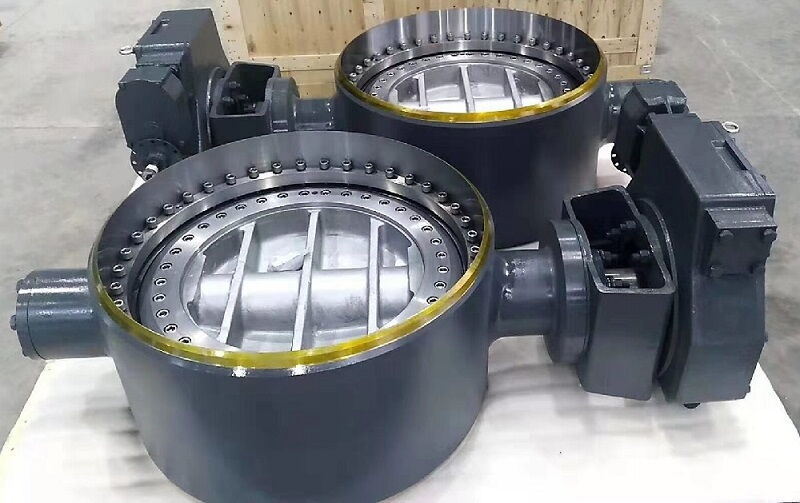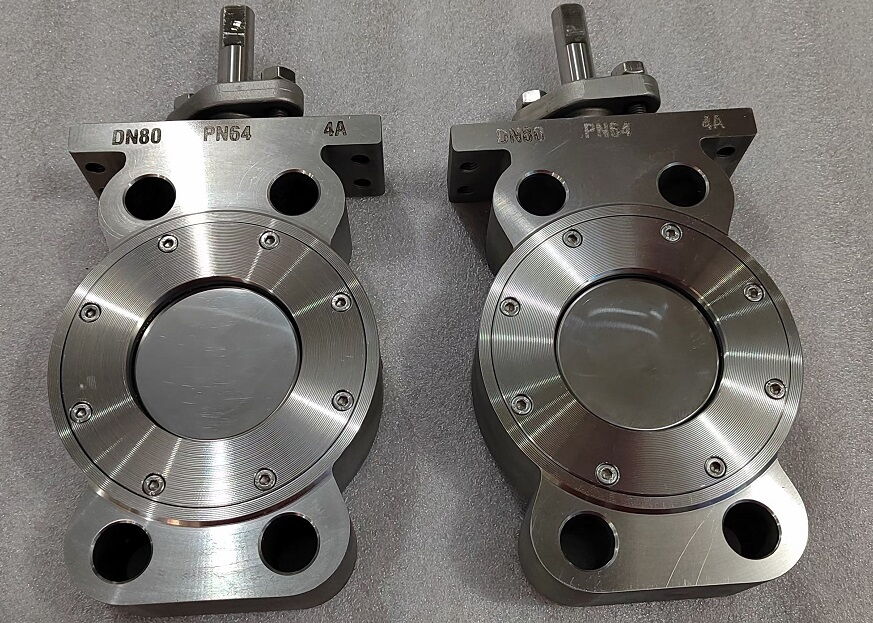The selection of valves can have a major impact on the efficiency, dependability, and performance of a system in the field of industrial fluid control. Due to their affordable price, cost-effectiveness, and compact design, butterfly valves and high-performance butterfly valves are two preferred options. Even though they may appear to be identical at first glance, they differ significantly and are important for different purposes. Conventional butterfly valves are usually used in low-pressure, low-temperature settings where a reasonable level of sealing is enough. They are made up of a flat disc that is fixed atop a revolving shaft and that opens and shuts to control flow.
Conversely, high-performance butterfly valves (HPBVs) offer better sealing, higher pressure ratings, and wider temperature tolerances because of their sophisticated features, which include double or triple offset designs. Thanks to these improvements, HPBVs can now be used in more demanding applications, such as those involving harsh chemicals, steam at high pressure, or extremely high or low temperatures. Knowing these differences can help you choose the best valve for your application and guarantee longevity, safety, and effectiveness in a variety of sectors, including chemical processing, water treatment, and oil and gas. In-depth discussion of the distinctions between standard butterfly valves and high-performance butterfly valves will be covered in this extensive guide, arming you with the information you need to make wise choices regarding your fluid control systems.
Because of its affordable, simple design, and ease of use, butterfly valves are a popular and adaptable type of valve in a variety of industrial applications. Butterfly valves are basically just a disc set on a spinning shaft. The disc stops fluid flow when the valve is closed; when the valve is open, the disc spins to let fluid pass through. Tight sealing and rapid shutdown are made possible by this design. Butterfly valves come in a variety of forms, but the most popular are concentric (also known as resilient-seated) valves, which include a flexible rubber seat that creates a tight seal and a disc that is positioned in the middle of the pipe.
Usually, low-pressure and low-temperature applications like water distribution systems or HVAC units employ these valves. In addition, there are butterfly valves that are triple eccentric (triple offset) and double eccentric (double offset), which are made to reduce wear and improve sealing at greater temperatures and pressures. While the triple-offset valve has a conical profile that guarantees zero leakage, the double-offset design shifts the disc away from the seat to reduce friction during operation. Butterfly valves are a great option for many applications because of their lightweight, small size, and capacity to fit into confined locations.
Their effectiveness may be constrained, though, in circumstances where exact flow control is necessary or when system efficiency may be impacted by significant pressure dips. Comprehending these facets of butterfly valves aids in the appropriate type's selection for particular industrial requirements, guaranteeing longevity and operational efficiency.

High-performance butterfly valves (HPBVs) are sophisticated fluid control mechanisms made to withstand the more demanding requirements of industrial settings where higher pressure ratings, larger temperature tolerances, and stronger sealing capabilities are necessary. The improved design elements of HPBVs, as opposed to normal butterfly valves, include double or triple offset designs. By arranging the disc in relation to the valve body and seat, these offsets reduce contact and friction during operation, hence enhancing the valve's dependability and longevity. Because of the double-offset design, which reduces wear and tear common to concentric butterfly valves, the disc is positioned slightly off-center from the shaft and seat.
With an extra conical profile on the disc and seat, the triple-offset design goes one step further in guaranteeing a metal-to-metal seal that offers remarkable leak-tight performance even in high-pressure and high-temperature situations. Because of this, HPBVs are perfect for important applications in sectors including oil and gas, petrochemical, power generation, and chemical processing, where exact control is crucial and operating conditions can be harsh. Moreover, the tough materials used to build HPBVs, such as advanced alloys or stainless steel, improve their resistance to corrosive fluids and aggressive media. In addition, these valves have superior throttling qualities than normal ones, which enable more accurate flow control.
High-performance butterfly valves are an excellent investment for challenging industrial environments because of their longer service life, better performance, and lower maintenance costs, even though their original cost is higher. Selecting the best valve solution to guarantee maximum system efficiency and dependability is made easier for industry professionals when they are aware of these complex features and benefits.
 High-performance butterfly valves (HPBVs) and butterfly valves differ primarily in their uses, capacities, and designs. Typical butterfly valves have a concentric construction, meaning that the seal is provided by a flexible rubber seat and the disc is centered inside the pipe. They are therefore appropriate for low-pressure, low-temperature applications such as HVAC systems and water distribution. HPBVs, on the other hand, have sophisticated double or triple offset designs that greatly improve their performance. By limiting contact between the disc and seat, these offsets improve sealing, raise pressure ratings, and tolerate higher temperatures while reducing friction and wear during operation.
High-performance butterfly valves (HPBVs) and butterfly valves differ primarily in their uses, capacities, and designs. Typical butterfly valves have a concentric construction, meaning that the seal is provided by a flexible rubber seat and the disc is centered inside the pipe. They are therefore appropriate for low-pressure, low-temperature applications such as HVAC systems and water distribution. HPBVs, on the other hand, have sophisticated double or triple offset designs that greatly improve their performance. By limiting contact between the disc and seat, these offsets improve sealing, raise pressure ratings, and tolerate higher temperatures while reducing friction and wear during operation.Specifically, the triple-offset construction guarantees a metal-to-metal seal, offering remarkable leak-tight integrity even in the most adverse circumstances. Because HPBVs are made of strong materials like advanced alloys or stainless steel and can withstand harsh environments and corrosive fluids better than other materials, they are perfect for important industries like petrochemical, power generation, and oil and gas. Standard butterfly valves are less expensive and simpler to install, but high-performance butterfly valves (HPBVs) offer more accurate flow control, enhanced dependability, and less maintenance over the long run, making them ideal for demanding industrial applications. This makes HPBVs a larger initial investment.
Each type of butterfly valve, including high-performance butterfly valves (HPBVs), has advantages and disadvantages that determine which applications they are best suited for. Standard butterfly valves are well-known for being straightforward, affordable, and simple to install. They are a sensible option for low-pressure, low-temperature systems like water distribution and HVAC units because of their lightweight construction and easy installation and maintenance. They might not offer the most dependable sealing in tough settings, and their limits with regard to pressure and temperature tolerances could result in leakage in more stressful circumstances.
HPBVs, on the other hand, have sophisticated double or triple offset designs that provide greater temperature tolerances, higher pressure ratings, and excellent sealing capabilities. These designs are built for enhanced performance. Because these valves are constructed from sturdy materials like stainless steel or sophisticated alloys, they are long-lasting and resistant to hostile and corrosive fluids. The more intricate design and greater initial cost of HPBVs, which may call for specialized knowledge for maintenance and installation, are among their disadvantages. Despite these disadvantages, HPBVs are a great option for crucial applications in sectors like oil and gas, petrochemical, and power generation due to their long-term benefits of lower maintenance, increased dependability, and precise flow control.
In summary, making educated decisions in the valve sector requires an awareness of the distinctions between high-performance butterfly valves (HPBVs) and regular butterfly valves. Both varieties of valves serve certain purposes and have special benefits, but they differ in terms of their functionality, uses, and design.
Standard butterfly valves are renowned for being straightforward, reasonably priced, and simple to install and maintain. These valves are ideal for low-pressure, low-temperature applications including water distribution systems, HVAC units, and general industrial use because of their flexible rubber seat and concentric shape. Although they function well enough in less demanding situations, their limits with regard to sealing, pressure, and temperature tolerance might cause problems in harsher settings.
High-performance butterfly valves, on the other hand, are made to fulfill stricter specifications and offer better sealing, higher pressure ratings, and wider temperature tolerances. The reduced wear and friction caused by the double and triple offset designs enhance longevity and dependability. These valves can withstand hostile environments and corrosive fluids since they are made of sturdy materials like stainless steel and sophisticated alloys. For crucial applications where accurate flow control and reliable performance are essential, such as those in the oil and gas, petrochemical, power generating, and chemical processing sectors, HPBVs are perfect.
HPBVs are more expensive initially and require more intricate installation and maintenance, but in the long run, they are a wise investment for harsh industrial settings because of their improved durability, dependability, and low maintenance needs. The final decision between an HPBV and a regular butterfly valve is made based on the particular needs of the application, such as the intended performance, operating conditions, and financial constraints.
Industry professionals can choose the best valve solution for their needs by fully comprehending the differences between these two types of butterfly valves. This improves operational safety and longevity in addition to increasing system efficiency and reliability. Keeping up with the most recent developments and industry best practices will be crucial to sustaining peak performance and succeeding in a range of industrial applications as the valve business continues to change. Ultimately, choosing wisely will improve results and increase satisfaction with your fluid control systems, regardless of whether you choose with a high-performance or regular butterfly valve.
